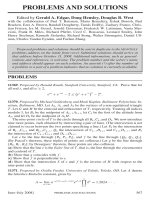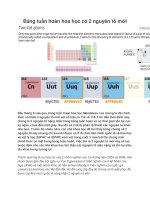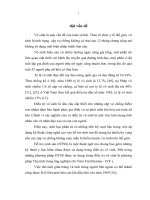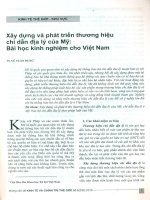Tạp chí toán học AMM tháng 6 2008
Bạn đang xem bản rút gọn của tài liệu. Xem và tải ngay bản đầy đủ của tài liệu tại đây (95.92 KB, 8 trang )
PROBLEMS AND SOLUTIONS
Edited by Gerald A. Edgar, Doug Hensley, Douglas B. West
with the collaboration of Paul T. Bateman, Mario Benedicty, Itshak Borosh, Paul
Bracken, Ezra A. Brown, Randall Dougherty, Tam
´
as Erd
´
elyi, Zachary Franco, Chris-
tian Friesen, Ira M. Gessel, Jerrold Grossman, Frederick W. Luttmann, Vania Mas-
cioni, Frank B. Miles, Richard Pfiefer, Cecil C. Rousseau, Leonard Smiley, John
Henry Steelman, Kenneth Stolarsky, Richard Stong, Walter Stromquist, Daniel Ull-
man, Charles Vanden Eynden, and Fuzhen Zhang.
Proposed problems and solutions should be sent in duplicate to the MONTHLY
problems address on the inside front cover. Submitted solutions should arrive at
that address before October 31, 2008. Additional information, such as general-
izations and references, is welcome. The problem number and the solver’s name
and address should appear on each solution. An asterisk (*) after the number of
a problem or a part of a problem indicates that no solution is currently available.
PROBLEMS
11369. Proposed by Donald Knuth, Stanford University, Stanford, CA. Prove that for
all real t,andallα ≥ 2,
e
αt
+ e
−αt
− 2 ≤
e
t
+ e
−t
α
− 2
α
.
11370. Proposed by Michael Goldenberg and Mark Kaplan, Baltimore Polytechnic In-
stitute, Baltimore, MD. Let A
0
, A
1
,and A
2
be the vertices of a non-equilateral triangle
T .LetG and H be the centroid and orthocenter of T , respectively. Treating all indices
modulo 3, let B
k
be the midpoint of A
k−1
A
k+1
,letC
k
be the foot of the altitude from
A
k
,andletD
k
be the midpoint of A
k
H.
The nine-point circle of T is the circle through all B
k
, C
k
,andD
k
. We now introduce
nine more points, each obtained by intersecting a pair of lines. (The intersection is not
claimed to occur between the two points specifying a line.) Let P
k
be the intersection
of B
k−1
C
k+1
and B
k+1
C
k−1
, Q
k
the intersection of C
k−1
D
k+1
and C
k+1
D
k−1
,andR
k
the intersection of C
k−1
C
k+1
and D
k−1
D
k+1
.
Let e be the line through {P
0
, P
1
, P
2
},and f be the line through {Q
0
, Q
1
, Q
2
}.
(By Pascal’s theorem, these triples of points are collinear.) Let g be the line through
{R
0
, R
1
, R
2
}; by Desargues’ theorem, these points are also collinear.
(a) Show that the line e is the Euler line of T , that is, the line through the circumcenter
and centroid of T .
(b) Show that g coincides with f .
(c) Show that f is perpendicular to e.
(d) Show that the intersection S of e and f is the inverse of H with respect to the
nine-point circle.
11371. Proposed by Ovidiu Furdui, University of Toledo, Toledo, OH. Let A denote
the Glaisher-Kinkelin constant, given by
A = lim
n→∞
n
−n
2
/2−n/2−1/12
e
n
2
/4
n
k=1
k
k
= 1.2824 ··· .
June–July 2008]
PROBLEMS AND SOLUTIONS 567
Evaluate in closed form
A
6
∞
n=1
e
−1
(1 + 1/n)
n
(−1)
n
.
11372. Proposed by Jennifer Vandenbussche and Douglas B. West, University of Illi-
nois at Urbana-Champaign, Urbana, IL. In a family of finite sets, let a splitting ele-
ment be an element that belongs to at least two of the sets and is omitted by at least
two of the sets. Determine the maximum size of a family of subsets of {1, ,n} for
which there is no splitting element.
11373. Proposed by Emeric Deutsch, Polytechnic University, Brooklyn, NY. Let S
n
be the symmetric group on {1, ,n}. By the canonical cycle decomposition of an
element π of S, we mean the cycle decomposition of π in which the largest entry of
each cycle is at the beginning of that cycle, and the cycles are arranged in increasing
order of their first elements.
Let ψ
n
: S
n
→ S
n
be the mapping that associates to each π ∈ S
n
the permuta-
tion whose one-line representation is obtained by removing the parentheses from the
canonical cycle decomposition of π . (Thus, the permutation
12345
34521
has one-line repre-
sentation 34521 and canonical cycle representation (42)(513) andismappedbyψ
5
to
42513.) Describe the fixed points of ψ
n
and find their number.
11374. Proposed by Harley Flanders and Hugh L. Montgomery, University of Michi-
gan, Ann Arbor, MI. Let a, b, c,andm be positive integers such that abcm = 1 + a
2
+
b
2
+ c
2
. Show that m = 4.
11375. Proposed by Cezar Lupu, student, University of Bucharest, Bucharest, Roma-
nia. The first Brocard point of a triangle ABC is that interior point for which the
angles BC, CA,andAB have the same radian measure. Let ω be that measure.
Regarding the triangle as a figure in the Euclidean plane R
2
, show that if the vertices
belong to Z × Z,thenω/π is irrational.
SOLUTIONS
Consecutive Squares with a Square Average
11227 [2006, 460]. Proposed by Syrous Marivani, Louisiana State University –
Alexandria, Alexandria, LA. Call an integer nblockyif n > 1andthereisarun
of n consecutive integer squares the average of which is a square. (Thus, 25 is blocky
because (
24
0
k
2
)/25 = 4900/25 = 14
2
, and 31 is the next blocky integer.)
(a) Determine the set B of blocky integers.
(b) Given a blocky integer n, give a procedure that determines all integers k that can
serve as starting points for required runs of squares.
(c) Give a formula in terms of n for the number of k that can serve as starting points
of required runs of squares.
Solution by Missouri State University Problem Solving Group, Springfield, MO.
(a) We prove that n is blocky if and only if n > 1andn ≡±1or±7 (mod 24).We
want to find integers k, n,andm such that
m
2
=
1
n
k+n−1
i=k
i
2
=
1
n
k+n−1
i=1
i
2
−
k−1
i=1
i
2
.
568
c
THE MATHEMATICAL ASSOCIATION OF AMERICA [Monthly 115
Using the standard formula
N
i=1
i
2
= N (N + 1)(2N + 1)/6 and algebraically simpli-
fying, we obtain m
2
= k
2
+ (n − 1)k + (n − 1)(2n − 1)/6. Thus (n − 1)(2n − 1)/6
must be an integer, which forces n ≡±1 (mod 6). Completing the square on the right
side yields m
2
=
(
k + (n − 1)/2
)
2
+ (n
2
− 1)/12, so
n
2
− 1
12
= m
2
−
k +
n − 1
2
2
=
m + k +
n − 1
2
m − k −
n − 1
2
.
Since n = 6l ± 1, (n − 1)/2 = 3l or 3l − 1, while (n
2
− 1)/12 = 3l
2
± l,whichis
an even integer. Because m + k + (n − 1)/2andm − k − (n − 1)/2havethesame
parity and their product is even, we have (n
2
− 1)/12 ≡ 0 mod 4. This forces n ≡±1
or ±7 (mod 24).Conversely,ifn is of this form, then (n
2
− 1)/12 = (2α)(2β),where
α and β are integers. Taking m = α + β and k = α − β − (n − 1)/2 proves that the
conditions are sufficient.
(b) Given a blocky integer n, taking all possible factorizations of the form (n
2
−
1)/12 = (2α)(2β) with α, β > 0 and setting k = α − β − (n − 1)/2 yields all pos-
sible starting points k for the summation. (Notice that if α =−a and β =−b with
a, b > 0, then k also arises from the positive factorization (n
2
− 1)/12 = (2a)(2b),
because k = α − β − (n − 1)/2 = b − a − (n − 1)/2.)
(c) From the construction above, we conclude that the number of such k is the
number of positive divisors of (n
2
− 1)/48, which is easily computed from its prime
factorization.
Also solved by K. Alpar-Vajk (Italy), M. R. Avidon, D. Beckwith, R. Chapman (U. K.), P. Corn, P. P. D
´
alyay
(Hungary), J. Ferdinands, J. W. Frommeyer, S. M. Gagola, Jr., E. A. Herman, O. P. Lossers (Netherlands),
P. Magli (Italy), L. Pebody, F. Sami, R. Stong, Z. V
¨
or
¨
os (Hungary), Con Amore Problem Group (Denmark),
GCHQ Problem Solving Group (U. K.), Microsoft Research Problems Group, NSA Problems Group, and the
proposer.
Inscribed Triangle Area
11261 [2006, 940]. Proposed by Isaac Sofair, Fredericksburg, VA. A triangle of area
1 has vertices A
1
, A
2
,andA
3
. The sides A
2
A
3
, A
3
A
1
,and A
1
A
2
subtend angles of
measure α
1
, α
2
,andα
3
, respectively, at an internal point P. The triangle has angles at
A
1
, A
2
,and A
3
of measure a
1
, a
2
,anda
3
, respectively. The extensions of A
1
P, A
2
P,
and A
3
P to their opposite sides meet those sides at B
1
, B
2
,andB
3
, respectively.
For 1 ≤ k ≤ 3, let T
k
= sin a
k
sin α
k
sin(α
k
− a
k
). For an even permutation p of
(1, 2, 3),letS
p
= (sin a
p
1
sin α
p
2
sin α
p
3
+ sin α
p
1
sin a
p
2
sin a
p
3
),andletS be the
product of S
p
over all three such permutations. Prove that the area of triangle B
1
B
2
B
3
is 2T
1
T
2
T
3
/S.
Solution by C. R. Pranesachar, Indian Institute of Science, Bangalore, India. Notation:
We write, for example, A
2
B
1
for the length of segment A
2
B
1
,and[PA
2
A
3
] for the
area of PA
2
A
3
.Ift
1
= A
2
B
1
/B
1
A
3
, t
2
= A
3
B
2
/B
2
A
1
,andt
3
= A
1
B
3
/B
3
A
2
,then
t
1
t
2
t
3
= 1 by Ceva’s theorem (see />alization/ceva.shtml
). Now
[A
1
B
3
B
2
]=
1
2
A
1
B
3
· A
1
B
2
sin a
1
=
1
2
t
3
1 + t
3
A
1
A
2
·
1
1 + t
2
A
1
A
3
sin a
1
=
t
3
(1 + t
3
)(1 + t
2
)
[A
1
A
2
A
3
].
June–July 2008]
PROBLEMS AND SOLUTIONS 569
From this and the two similar relations for [A
2
B
1
B
3
] and [A
3
B
2
B
1
] we get
[B
1
B
2
B
3
]=[A
1
A
2
A
3
]−[A
1
B
3
B
2
]−[A
2
B
1
B
3
]−[A
3
B
2
B
1
]
=
2
(1 + t
1
)(1 + t
2
)(1 + t
3
)
[A
1
A
2
A
3
].
Subtracting areas, we have
[A
1
A
2
B
1
]
[A
1
B
1
A
3
]
= t
1
,
[PA
2
B
1
]
[PB
1
A
3
]
= t
1
, so
[PA
1
A
2
]
[PA
3
A
1
]
= t
1
,
and similarly for t
2
, t
3
.
Now write
a
1
= x
1
+ x
2
a
2
= y
1
+ y
2
a
3
= z
1
+ z
2
dividing the angles us-
ing lines through P as
shown in the diagram.
A
2
A
1
B
1
A
3
B
3
B
2
y
2
y
1
z
2
z
1
α
1
α
2
α
3
x
1
x
2
P
We obtain
sin x
1
sin z
2
=
(A
2
P/A
1
A
2
) sin α
3
(A
2
P/A
2
A
3
) sin α
1
=
sin α
3
sin a
1
sin α
1
sin a
3
.
Also x
1
+ z
2
=
A
1
PA
3
−
A
1
A
2
A
3
= α
2
− a
2
. Observe that if sin θ/sin φ = k and
θ + φ = β,then
tan θ =
k sin β
1 + k cos β
and tan φ =
sin β
k + cos β
.
Therefore
tan z
2
=
sin a
3
sin α
1
sin(α
2
− a
2
)
sin a
1
sin α
3
+ sin a
3
sin α
1
cos(α
2
− a
2
)
.
Similarly (interchanging suffixes 2 and 3)
tan y
1
=
sin a
2
sin α
1
sin(α
3
− a
3
)
sin a
1
sin α
2
+ sin a
2
sin α
1
cos(α
3
− a
3
)
.
Hence
[PA
2
A
3
]=
1
2
(A
2
A
3
)
2
tan y
1
tan z
2
tan y
2
+ tan z
2
=
(A
2
A
3
)
2
2
sin a
2
sin a
3
sin α
1
sin(α
2
− a
2
) sin(α
3
− a
3
)
sin a
3
sin(α
2
− a
2
)
{
sin a
1
sin α
2
+ sin a
2
sin α
1
cos(α
3
− a
3
)
}
+ sin a
1
sin(α
3
− a
3
)
{
sin a
1
sin α
3
+ sin a
3
sin α
1
cos(α
2
− a
2
)
}
=
[A
1
A
2
A
3
] sin a
1
sin α
1
sin(α
2
− a
2
) sin(α
3
− a
3
)
sin a
p
1
sin a
p
2
sin α
p
3
sin(α
p
3
− a
p
3
)
,
570
c
THE MATHEMATICAL ASSOCIATION OF AMERICA [Monthly 115
where
is the sum over the even permutations. Writing
x = sin a
1
sin α
1
sin(α
2
− a
2
) sin(α
3
− a
3
),
y = sin a
2
sin α
2
sin(α
3
− a
3
) sin(α
1
− a
1
),
z = sin a
3
sin α
3
sin(α
1
− a
1
) sin(α
2
− a
2
),
we have t
1
= z/y, t
2
= x/z, t
3
= y/x.So
xyz = T
1
T
2
T
3
sin(α
1
− a
1
) sin(α
2
− a
2
) sin(α
3
− a
3
),
y + z = sin(α
1
− a
1
)
[
sin a
2
sin α
2
sin(α
3
− a
3
) + sin a
3
sin α
3
sin(α
2
− a
2
)
]
.
Expanding and rearranging gives
y + z = sin(α
1
− a
2
)
[
sin a
2
sin a
3
sin α
1
+ sin a
1
sin α
2
sin α
3
]
= sin(α
1
− a
1
) S
(123)
.
Using this and similar formulas for z + x and x + y,weget
[B
1
B
2
B
3
]=
2T
1
T
2
T
3
S
[A
1
A
2
A
3
],
as desired.
Also solved by V. Schindler (Germany) and the proposer.
A Combinatorial Inequality
11269 [2007, 78]. Proposed by Herv
´
e Moulin, Rice University, Houston, TX. Let n be a
positive integer and let a
1
, ,a
n
be nonnegative real numbers. For integers 1 ≤ k ≤
n,andfor p ≥ 1, let A(k, p) =
S
j ∈S
a
j
p
, where the outer summation extends
over all subsets of {1, ,n} having exactly k elements. Thus, A(n, p) =
n
j =1
a
j
p
while A(1, p) =
n
j =1
a
p
j
.
(a) Show that if p ≥ n − 1or p is a positive integer, then
A(n, p)
n
≤
n−1
k=0
(−1)
k
A(n − k, p)
k + 1
.
(b) Show that if p ≥ n or p is a positive integer, then
n−1
k=0
(−1)
k
A(n − k, p)
k + 1
≤
1
n + 1
n + 1
n
p
A(n, p).
(c)
∗
Does the conclusion of part (a) hold also for nonintegral p with 1 < p < n − 1?
Solution by the editors. (a) More generally, let f be a function differentiable n times,
such that f (x), , f
(n)
(x) ≥ 0on(0, ∞) and f (0) = 0. For any subset S of [n] let
a
S
=
s∈S
a
s
, b
S
=
T ⊆S
(−1)
|S|−|T |
f (a
T
).
Note that for nonempty S, b
S
is an |S|-fold iterated finite difference of f .Bythe
mean value theorem there is some ξ ∈ (0,
s∈S
a
s
) with b
S
=
s∈S
a
s
f
(|S|)
(ξ).In
particular, b
S
≥ 0 for nonempty S,andb
∅
= 0. Also note that by inclusion-exclusion,
f (a
S
) =
T ⊆S
b
T
.
June–July 2008] PROBLEMS AND SOLUTIONS 571
Hence
S⊆[n]
(−1)
n−|S|
n + 1 −|S|
f (a
S
) =
S⊆[n]
(−1)
n−|S|
n + 1 −|S|
T ⊆S
b
T
=
T ⊆[n]
b
T
S⊃T
(−1)
n−|S|
n + 1 −|S|
=
T ⊆[n]
b
T
n−|T |
k=0
(−1)
k
k + 1
n −|T |
k
=
T ⊆[n]
b
T
n + 1 −|T |
≥
1
n
T ⊆[n]
b
T
=
1
n
f
n
j =1
a
j
.
Here in the third equality we let k = n −|S|. For the inequality we have used b
T
≥ 0
for nonempty T ,andb
∅
= 0. For part (a) we take f (x) = x
p
, which has the desired
nonnegativity property exactly when p ≥ n − 1or p is a positive integer. For use in
part (b), note that similarly
S⊆[n]
(−1)
n−|S|
n + 2 −|S|
f (a
S
) =
T ⊆[n]
b
T
n−|T |
k=0
(−1)
k
k + 2
n −|T |
k
=
T ⊆[n]
b
T
(n + 1 −|T |)(n + 2 −|T |)
≥ 0
(b) We show that if f is an n + 1-times differentiable function such that f (0) = 0
and f (x), , f
(n+1)
(x) ≥ 0on(0, ∞),then
S⊆[n]
(−1)
n−|S|
n + 1 −|S|
f (a
S
) ≤
1
n + 1
f
n + 1
n
n
j =1
a
j
.
The desired result is then the special case f (x) = x
p
.LetF(a
1
, ,a
n
) denote the
left side of this desired inequality and suppose that a
n
> a
n−1
.Since
∂ F
∂a
k
=
S:k∈S
(−1)
n−|S|
n + 1 −|S|
f
(a
S
),
we have
∂ F
∂a
n
−
∂ F
∂a
n−1
=−
S⊆[n−2]
(−1)
n−2−|S|
(n − 2) + 2 −|S|
f
(
a
n
+ a
S
)
− f
(
a
n−1
+ a
S
)
≤ 0.
Here for the inequality we have used the result of the previous paragraph for the func-
tion g given by g(x) = f
(a
n
+ x) − f
(a
n−1
+ x). Since the symmetric result holds
for the other variables, it follows that for fixed
n
j =1
a
j
, F attains its maximum when
a
1
= ··· =a
n
. Thus it suffices to prove the inequality when a
1
=··· = a
n
= a.Ifwe
take a
1
=··· = a
n
= a
n+1
= a then
b
[n+1]
=
n+1
k=0
(−1)
n+1−k
n + 1
k
f (ka) = f ((n + 1)a) −
n
k=0
(−1)
n−k
(n + 1)
n + 1 − k
f (ka).
Since b
[n+1]
≥ 0,
n
k=0
(−1)
n−k
n + 1 − k
f (ka) ≤
1
n + 1
f ((n + 1)a).
572
c
THE MATHEMATICAL ASSOCIATION OF AMERICA [Monthly 115
This is exactly the desired inequality in the case where a
1
=··· = a
n
= a. Note that if
f (x) = x
p
with n − 1 < p < n,then f
(n+1)
(x)<0on(0, ∞). Hence b
[n+1]
< 0and
the reverse inequality holds. Thus (b) does not hold for n − 1 < p < n.
Editorial comment. No solution of (c)
∗
is available.
Parts (a) and (b) were also solved by the proposer.
The Euler Line After All
11272 [2007, 164]. Proposed by Vasile Mihai, Belleville, ON, Canada. Let ABC be
an acute nonequilateral triangle, and let H be its orthocenter, O its circumcenter, and
K its symmedian point (defined below). Let R be the circumradius of ABC.LetL be
the line through H and parallel to the line segment KO.
(a) Show that there are exactly two solution points V on L to the equations
|VA|
|BC|
=
|VB|
|CA|
=
|VC|
|AB|
. (1)
(b) For the solutions V
1
and V
2
in (a), show that |HV
1
|·|HV
2
|=4R
2
.
(The symmedian point of a triangle is the point of concurrence of its three symmedian
lines. The symmedian line through A is the reflection of the line through A and the cen-
troid of ABC across the line bisecting angle BAC, and the symmedian lines through
B and C are defined similarly. For more about the symmedian point, see Ross Hons-
berger’s Episodes in Nineteenth and Twentieth Century Euclidean Geometry, MAA,
Washington, DC, 1995.)
Solution by Sin Hitotumatu, Kyoto University, Kyoto, Japan. The points V satisfying
(1) lie on the Apollonius circles
V :
|VA|
|VB|
=
|BC|
|CA|
and
V :
|VA|
|VC|
=
|BC|
|AB|
,
so there are at most two such points.
The problem is not correct as stated. We show that the two solution points that
satisfy (1) lie instead on the Euler line HO.
Let |BC|=a, |CA|=b, |AB|=c,
−→
OA = a,
−→
OB = b,
−→
OC = c.
Lemma 1. If
−→
OP = αa + βb + γ c,then
−→
OP
2
= R
2
(α + β + γ)
2
− (a
2
βγ +
b
2
γα+ c
2
αβ).
Proof. With ·, · denoting the inner product,
−→
OP
2
= (α
2
+ β
2
+ γ
2
)R
2
+ 2αβ a, b+2βγ b, c+2γαc, a.
Now a, b =ab cos 2C = R
2
(1 − 2sin
2
C) = R
2
− c
2
/2bythelawofsines;
similarly for the other two inner products. Therefore,
−→
OP
2
= R
2
(α
2
+ β
2
+ γ
2
+
2αβ + 2βγ + 2γα)− c
2
αβ − b
2
γα− a
2
βγ.
Lemma 2. If A BC is an acute non-equilateral triangle, then 8R
2
< a
2
+ b
2
+
c
2
< 9R
2
.
Proof. Since
−→
OH = a + b + c, we conclude from Lemma 1 that |OH|
2
= 9R
2
−
(a
2
+ b
2
+ c
2
) ≥ 0, with equality only if H = O (that is, ABC is equilateral).
For the left inequality, writing s = (a + b + c)/2, we have
a
2
+ b
2
+ c
2
R
2
=
16s
2
(4Rs)
2
(a
2
+ b
2
+ c
2
)
=
a
2
+ b
2
+ c
2
a
2
b
2
c
2
(−a
4
− b
4
− c
4
+ 2a
2
b
2
+ 2b
2
c
2
+ 2c
2
a
2
)
June–July 2008]
PROBLEMS AND SOLUTIONS 573
by Heron’s formula, and then
a
2
+ b
2
+ c
2
R
2
− 8
a
2
b
2
c
2
= (a
2
+ b
2
+ c
2
)
− (a
2
+ b
2
+ c
2
)
2
+ 4(a
2
+ b
2
+ c
2
)(a
2
b
2
+ b
2
c
2
+ c
2
a
2
) − 8a
2
b
2
c
2
= (a
2
+ b
2
+ c
2
− 2a
2
)(a
2
+ b
2
+ c
2
− 2b
2
)(a
2
+ b
2
+ c
2
− 2c
2
),
which is positive since ABC is acute.
Now let
−→
OV =
−→
OH − λ(a + b + c),whereλ is a parameter. This is a parametric
description of the Euler line HO,sinceλ = 0 corresponds to V = H and λ = 1cor-
responds to V = O.Since
−→
AV =
−→
OV −
−→
OA =−λa + (1 − λ)b + (1 − λ)c,wesee
by Lemma 1 that
|AV |
2
= R
2
(−λ + 1 − λ + 1 − λ)
2
− a
2
(1 − λ)
2
+ b
2
λ(1 − λ) + c
2
λ(1 − λ)
= R
2
(2 − 3λ)
2
+ λ(1 − λ)(a
2
+ b
2
+ c
2
) + (λ − 1)a
2
.
Therefore, if we can take λ satisfying the equation
R
2
(2 − 3λ)
2
+ λ(1 − λ)(a
2
+ b
2
+ c
2
) = 0, (2)
then we have |AV|
2
= (λ − 1)a
2
. Similarly, for the same λ we have |BV|
2
=
(λ − 1)b
2
and |CV|
2
= (λ − 1)c
2
, so we obtain the relation (1).
Let p(λ) be the quadratic expression on the left in (2). Then
p(λ) =
9R
2
− (a
2
+ b
2
+ c
2
)
λ
2
−
12R
2
− (a
2
+ b
2
+ c
2
)
λ + 4R
2
.
The leading coefficient 9R
2
− (a
2
+ b
2
+ c
2
), call it ρ, is positive by Lemma 2. The
discriminant
12R
2
− (a
2
+ b
2
+ c
2
)
2
− 16R
2
ρ
= (16 − 24)R
2
(a
2
+ b
2
+ c
2
) + (a
2
+ b
2
+ c
2
)
2
= (a
2
+ b
2
+ c
2
)(a
2
+ b
2
+ c
2
− 8R
2
)
is positive by Lemma 2. This means that the equation (2) has two distinct roots λ
1
and
λ
2
.Since p(0)> p(1)>0, we have λ
1
,λ
2
> 1. So λ
1
and λ
2
give the desired points
V
1
and V
2
, which lie on the Euler line HO. Finally,
|HV
1
||HV
2
|=λ
1
λ
2
a + b + c
2
=
4R
2
ρ
9R
2
− (a
2
+ b
2
+ c
2
)
= 4R
2
.
Also solved by GCHQ Problem Solving Group (U. K.).
574
c
THE MATHEMATICAL ASSOCIATION OF AMERICA [Monthly 115









